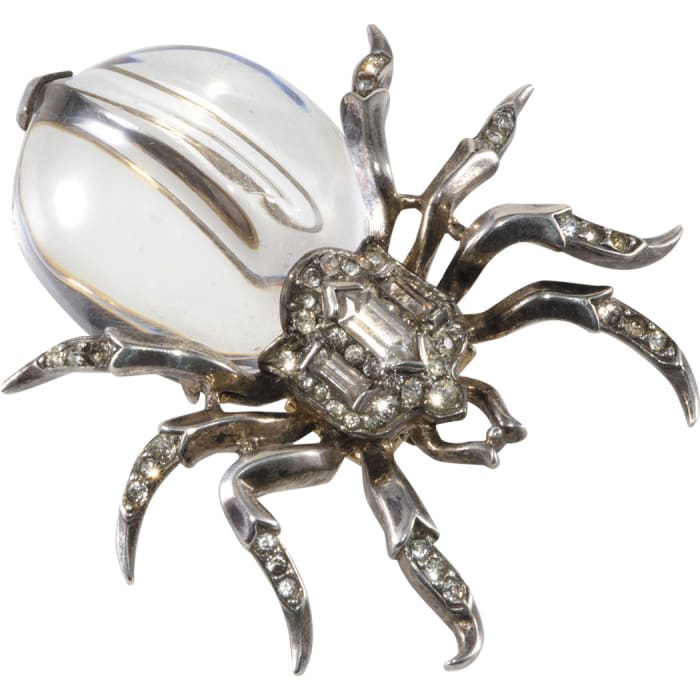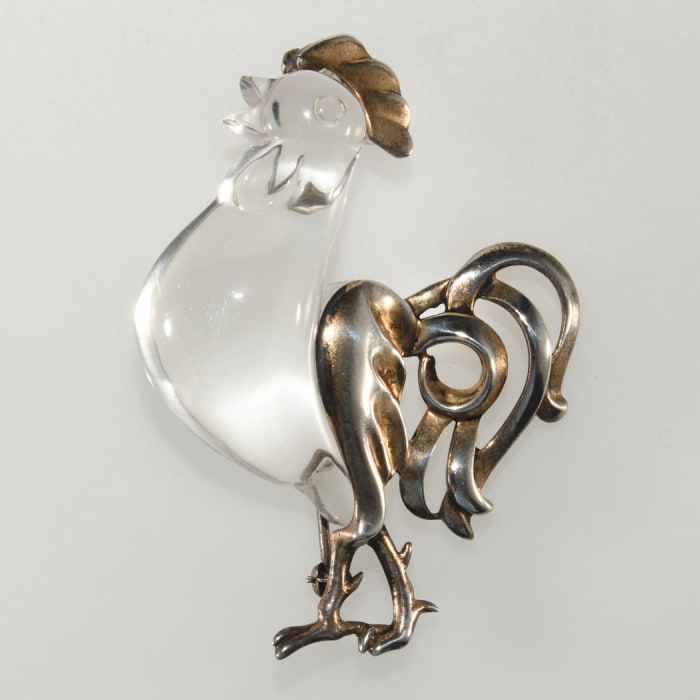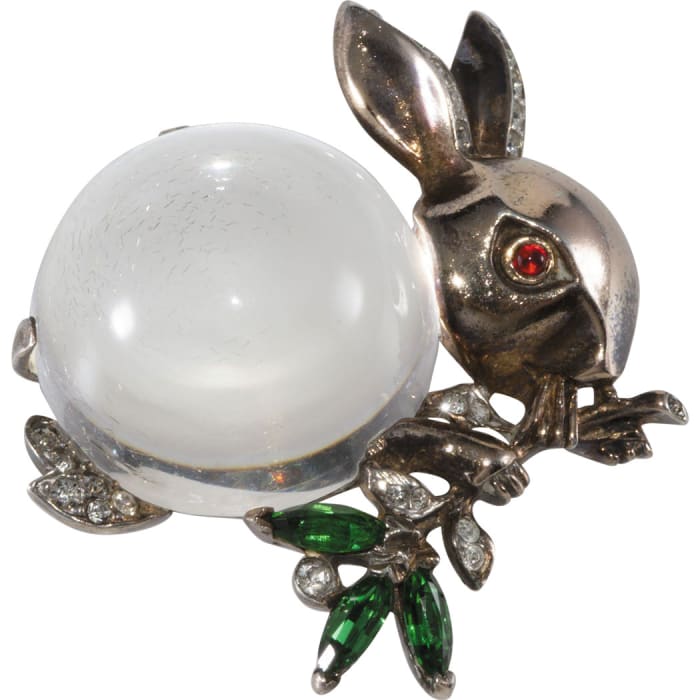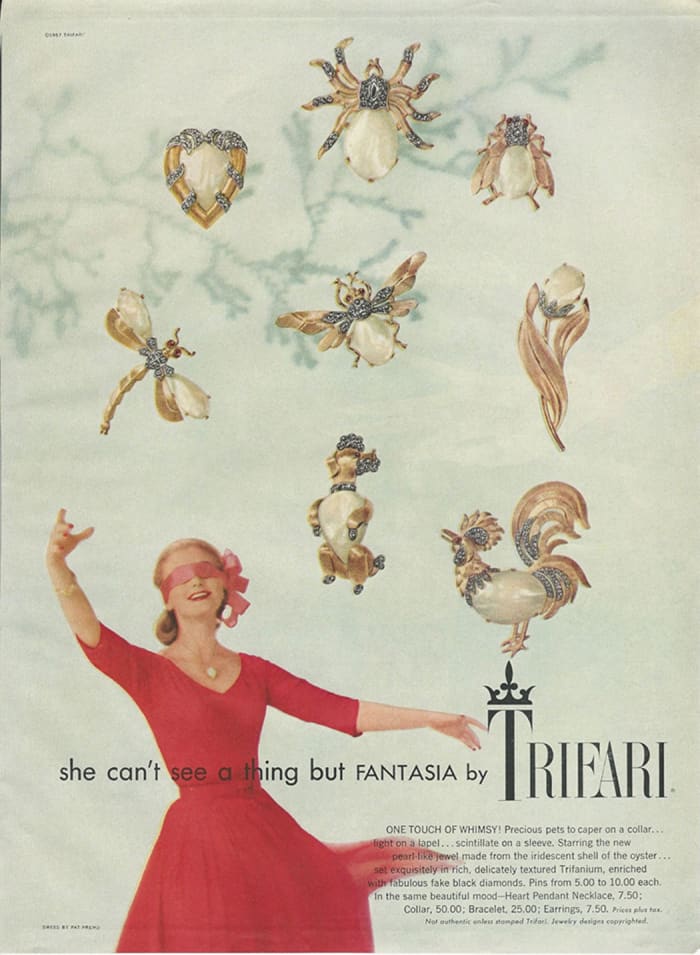while collectors might disagree on some of the background information shared about what we call “jelly belly” jewelry, there’s no doubt about its desirability. Some of the rarest examples can sell for thousands, in fact.
Learn more about this subset of vintage costume jewelry collecting featuring fun and fanciful figurals.
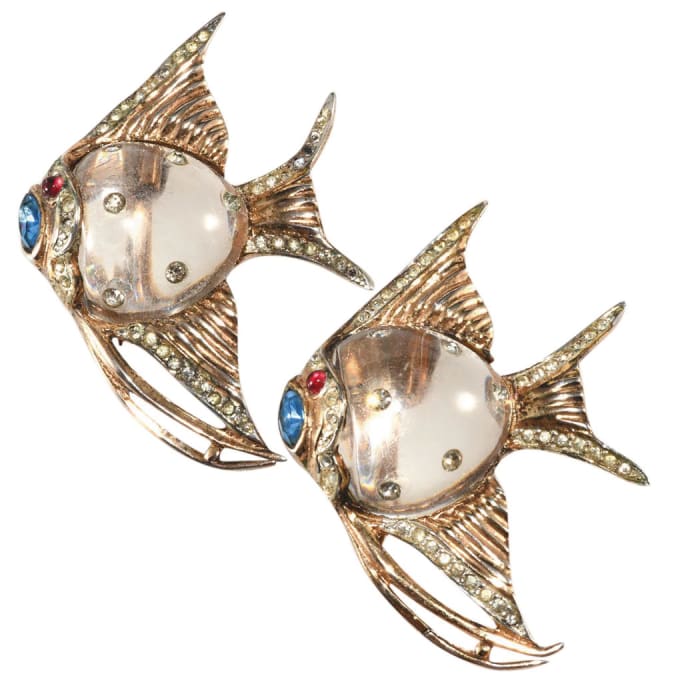
Coro Angel Fish jelly belly pin clip set (originally part of a separable Duette brooch) patented 1944: $225-S275.
Image courtesy Jay B. Siegel
WHAT IS A JELLY BELLY?
The manufacturers of jelly belly pieces called them “clear belly” jewelry when they were new. Most were made during the 1940s. Decades later, the term jelly belly was coined by collectors.
Inspired by fine jewelry produced using rock crystal and precious metals, these unique designs usually have a piece of polished clear Lucite that forms the mid-section of an animal brooch. The clear plastic can be round and domed or take on another more appropriate shape depending on the animal being emulated. The Lucite elements were sometimes carved to give them more distinctive shapes. Some are also decorated with smattering of inset rhinestones.
Departures from the norm include pieces shaped like flowers, hearts, and frog-topped lily pads along with a few others. Very occasionally pieces are found with colored plastic (but never glass), usually in red or blue, but they are always part of a figural design to be considered a true jelly belly.
The remainder of the jelly belly design is made up of metal. Sterling silver was commonly used with some pieces having a gold wash. Designs made with plated base metals and brass have also been found by collectors. The metalwork can be plain, decorated with enameling, or adorned with small rhinestones.
Both pin backs with safety catches and double-pronged pin clips (often described by collectors as “fur clips”) were used for fasteners on jelly belly brooches. Coordinating earrings, even though they aren’t always figurals, are usually described as jelly belly jewelry as well.
TRIFARI’S JELLY BELLY
Costume jewelry devotees recognize Trifari as the top manufacturer of jelly belly jewelry. Located in Providence, Rhode Island, this firm was one of the most prolific producers of fashionable adornment over several decades beginning in the 1930s. Some of the jelly belly designs they made in the ‘40s can sell for thousands. Most of these were designed by Alfred Phillipe, one of the most celebrated designers in costume jewelry history.
For example, a parrot pin clip with a Lucite belly shaped like a moon sliver and several different flower brooches can bring $3,000-$4,500 apiece. Poodles, Airedales, and Pekinese dogs are some of the costliest canine jelly bellies bringing $1,500-$2,000 each. Trifari produced dozens of other designs including the more affordable fly pins available in a variety of sizes, small birds, and seashells. Some were closely copied by other companies.
As for the origin of the clear plastic used to craft this type of jewelry, former Trifari employee Irving Wolf shared a unique bit of World War II-related history during a collector’s convention in the early 2000s. Believe it or not, the material was originally intended for airplane windows. When plagued by manufacturing flaws the slabs weren’t suitable for that purpose, so they were cut and polished for use in jewelry instead. However, some collectors who can’t find references for this use in historical documentation such as newspaper or magazine articles have questioned the accuracy of the airplane window attribution.
Other jewelry historians find Wolf’s account to be credible not only because he worked for Trifari for 41 years ending his career with the company as president, chairman, and chief operating officer, but because it was common practice for jewelry manufacturing companies to partner with other firms in the production of war-related goods. It stands to reason that Trifari would have contacts with manufacturers of airplanes as a result. Many alternative materials were used to produce jewelry during the period so repurposing plastics in this way is highly plausible and quite ingenious.
JELLY BELLY BY CORO
Coro, also located in Providence, was another major manufacturer of costume jewelry during its heyday. In addition to a wide range of jewelry at a variety of price points, they also produced numerous jelly belly designs. These can be found marked solely Coro or Coro Craft.
Some Coro clear belly pieces closely emulated Trifari designs. One example is a rabbit brooch made first by Trifari in 1943 and then Coro introduced a similar version in 1944. Many of the company’s styles, however, are totally unique.
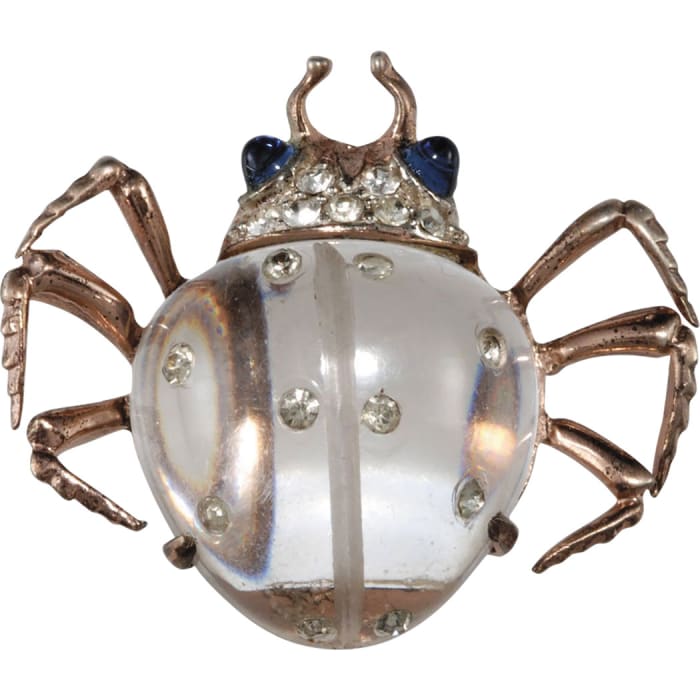
Coro single Twinkling Twins jelly belly pin clip, patented 1944: $125-$175.
Image courtesy Jay B. Siegel
Among Coro’s most coveted pieces are a colorfully enameled cornucopia brooch that incorporates a parrot, and a fruit basket design also featuring enameled fruit. Other desirable Coro examples make up separable Duettes that can be worn together as a brooch or apart as a pair of pin clips. A pair of Lucite bug pins called “Twinkling Twins” was also advertised in Harper’s Bazaar in 1944.
While the patents for many of these popular pieces were filed by a Coro executive named Adolf Katz, it was the company’s lead designer Gene Verri who conceived most of them. Nevertheless, Katz continually gets credit for Verri’s work since his name is found on the patents.
Although jelly belly pieces produced by Coro are generally not as highly valued as Trifari examples, the majority sell in the hundreds and are still considered to be desirable collectibles.
OTHER MANUFACTURERS
Other smaller companies like Fred A. Block, Leo Glass, Norma, and Elzac marketed jelly belly pieces as well. Although these are more uncommon names in costume jewelry history in comparison to Trifari and Coro, the jewelry they made can still be quite valuable.
Some of the most desirable jelly belly designs among these lesser-known businesses were produced by Leo Glass. With Lucite elements shaped like seahorses and water, these depictions are sea life are highly valued among collectors and usually sell in the thousands.
Elzac is better known for producing unmarked “Victims of Fashion” brooches depicting women’s faces made of ceramic material embellished with fabric and/or plastics. The company did produce at least one jelly belly, however, called “Freshie the College Boy Penguin.” The spectacle-wearing bird made using sterling silver was advertised in Women’s Wear Daily in 1945.
Occasionally cute jelly belly designs are found with no mark to indicate the manufacturer. These may be only marked sterling or have no marks at all if other types of metal were used.
LEARNING MORE
Although no books exclusively dedicated to the topic of jelly bellies have been published to date, recommended resources are both the A-M and N-Z editions of American Costume Jewelry Art & Industry, 1935-1950, by jewelry historians Carla Ginelli Brunialti and Roberto Brunialti. These books show many of the most desirable pieces of jelly belly jewelry alongside patent renderings providing both eye candy and useful information.


